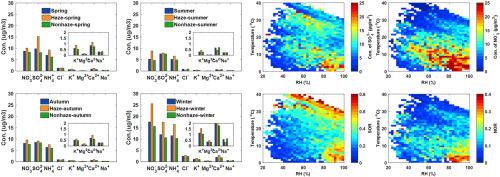Atmospheric Pollution Research ( IF 4.5 ) Pub Date : 2021-01-05 , DOI: 10.1016/j.apr.2021.01.003 Lin Zang , Yi Zhang , Bo Zhu , Feiyue Mao , Yu Zhang , Zemin Wang

|
Due to the rapid economic development in Central China, PM2.5 (particles not larger than 2.5 μm) pollution is serious in recent years. To fully understand the causes of PM2.5 in this region, we conducted a long-term tracking (2015–2018) on water-soluble inorganic ions (WSIIs) in PM2.5, including sulfate (SO42−), nitrate (NO3−), ammonium (NH4+), chlorine (Cl−), potassium (K+), calcium (Ca2+), sodium (Na+), and magnesium (Mg2+). Results indicate that each ion has significant seasonal variations, with the maximum concentration in winter and minimum in summer. The secondary inorganic aerosols (SIAs) have remarkably higher concentrations in haze periods than non-haze periods, which indicates that the outbreak of haze is closely related to the massive generation of SIAs. Moreover, each ion shows a different response to the variation of meteorology, implying the different formation mechanisms. Generally, high pollution levels of Ca2+, Mg2+, K+, Cl−, and Na+ are correlated to prevailing winds, suggesting the significant contribution of regional transport. High concentrations of SIAs are usually accompanied by the low temperature (T < 15 °C), high relative humidity (RH > 60%), and calm wind, which means they are mainly locally generated. Under conditions with low T and high RH, more gaseous sulfur and nitrogen tend to be converted into solid inorganic salts, proved by the higher oxidation efficiency. Different to NO3−, SO42− is also easily generated at high T through photochemical oxidization. This study interprets fine particle pollution from the perspective of particle composition, and the results provide an reference for regional air pollution prevention.
中文翻译:

中部武汉市水溶性无机气溶胶污染特征及其气象响应
由于中部地区经济的快速发展,近年来PM 2.5(不大于2.5μm的颗粒物)的污染非常严重。为了充分理解PM的原因2.5在该区域中,我们在PM进行了水溶性无机离子(WSIIs)长期跟踪(2015年至2018年)2.5,包括硫酸盐(SO 4 2- ),硝酸根(NO 3 - ),铵(NH 4 +),氯(Cl - ),钾(K +),钙(Ca 2+),钠(Na +),和镁(Mg 2+)。结果表明,每个离子都有明显的季节性变化,冬季最高,夏季最低。次生无机气溶胶(SIA)在霾期的浓度明显高于非霾期,这表明霾的爆发与SIA的大量产生密切相关。此外,每个离子对气象变化表现出不同的响应,这意味着不同的形成机制。通常,钙的高污染水平2+,镁2+,K +,氯-和Na +与盛行风相关,表明区域交通的重大贡献。高浓度的SIA通常伴随着低温(T <15°C),高相对湿度(RH> 60%)和平静的风,这意味着它们主要是局部产生的。在低T和高RH的条件下,更多的气态硫和氮倾向于转化为固体无机盐,这由较高的氧化效率证明。不同,以NO 3 -,SO 4 2-也容易在高Tg通过光化学氧化生成。本研究从颗粒组成的角度解释了细颗粒物的污染情况,为区域空气污染的防治提供了参考。



























 京公网安备 11010802027423号
京公网安备 11010802027423号